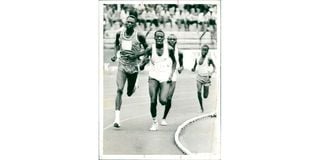Premium
Down memory lane, and the change of guard

John Ngugi (right) leads Moses Tanui in a local race on June 17, 1988.
What you need to know:
- The following year, Loruope began her journey to marathon greatness.
- Nonetheless, Kenya women won their first team women’s gold. But good tidings were on the way.
During the third decade of World Athletics Cross Country Championships at the Jaureguibarría Course in Amorebieta, Spain on March 28, 1993.
John Ngugi exits, William Sigei enters, and a rather short-tempered youth named Josphat Machuka.
The world cross country of that year signalled a change of guard in a generational crossover.
The athletes who had ruled in cross country from 1985 were over the hill with their understudies eager to continue the tradition.
Ethiopia was fast closing the gap after losing the dominance it held in the 1981-1985 period.
There was keen interest in the junior men’s 8km race where Machuka was the star attraction.
Machuka had during the 1992 World Athletics Junior Championships in Seoul, South Korea, punched Ethiopian legend Haile Gebrsellasie on the back of his neck after he produced a devastating kicking and won the 10,000 metres final in a sprint finish.
Machuka, who had dominated the race, was disqualified.
Nobody wanted to enter into the way of the Kenyan who finished third behind Philip Mosima and Christopher “Jogoo” Kosgei in the junior race.
Machuka went on to finish fifth in the 10,000m race during the 1996 Atlanta Olympic Games. Gebrselassie won the race.
Gebrsellasie, who never made a mark in cross country, went to torment Kenyans for a decade and became a friend of Kenyan runners such as the legendary Paul Tergat.
At the 10,000m race of the 1993 Stuttgart World Athletics Championships, the Ethiopian denied Kenya a straight third world title when he took the first of his four gold medals at the event.
The Ethiopian began clipping the heels of the Kenyan champion, Moses Tanui, with four laps remaining in the 25-lap race.
Tanui shouted at Gebrselassie to stop, but the Ethiopian continued his unnerving tactic until he ripped a hole in Tanui’s left shoe, which the Kenyan discarded. He sprinted in the last lap without one shoe and confronted Gebrsellasie as he protested with about the torn shoe.
But after that incident, the Ethiopian got his groove, growing in stature as one of the finest distance runners of his generation.
Kenyan William Sigei, who was to win the world title for two straight years, was a tenacious athlete.
Tergat, the local sensation of 92 had suffered a serious injury which kept him away as Sigei appeared with all intent to take over from Ngugi, winning in 1993 and 1994.
As Sigei ruled, Mosima who had finished 11th in the final trials for the 1988 Seoul Olympics Games, sensationally challenged the big names of the day such as Ngugi.
Kosgei, who started off running barefoot, grew to become the world steeplechase champion in 1999.
Portuguese Albertina Dias, Catherina McKiernan from Ireland and American Lynn Jennings dominated to sweep the podium places in women’s senior race in Amorebieta 1993.
Pauline Konga, who three years later won a silver in the 5,000m at the Atlanta Olympic Games, finished seventh, Helen Kimaiyo 12th, Jane Ngotho 17th, Lydia Cheromei 32nd and Tegla Loroupe 80th.
The following year, Loruope began her journey to marathon greatness.
Nonetheless, Kenya women won their first team women’s gold. But good tidings were on the way.




